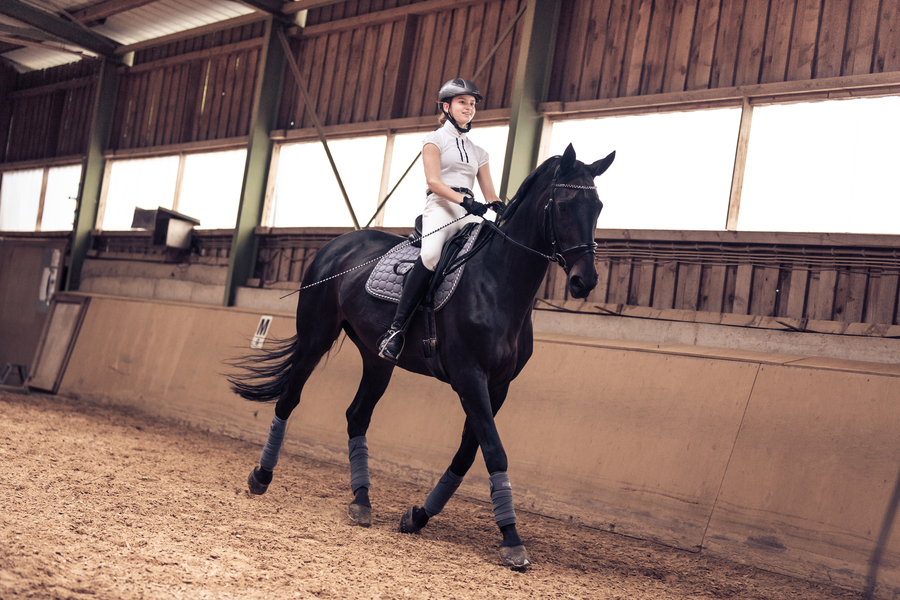
Are you ready to take the next step in your horse riding experience? Before you can become truly great at riding horses, you need to practice your skills. And when you want to practice in a safe environment, there’s no better choice than building your own riding arena for your horse.
Horseback riding is a great sport, and it is also a great hobby. But in order for you to become a great horseback rider, you need to practice. The best way to practice and get the most out of your practice time is to practice in an arena. You can purchase a horseback riding arena or build it yourself if you wish to save some money!
Keep reading to find out how you can build your riding arena on a budget.
Consider the Location
Considering the location of your riding arena is essential when planning your budget. It will affect a lot of the logistics of building, and there are a few things to consider alongside your horse arena plans:
- Which way does the wind blow?
- Is there space for water runoff?
- Are there any areas that will retain water?
- How does the sun hit the site?
- Will you need to landscape the area?
Don’t forget to check your local laws on building restrictions. Just because you want your arena in a specific place doesn’t mean you can start building immediately. Your local laws may restrict the size and location of your area, so do some research on zoning, building, and conservation before you start planning.
Fencing or No Fencing?
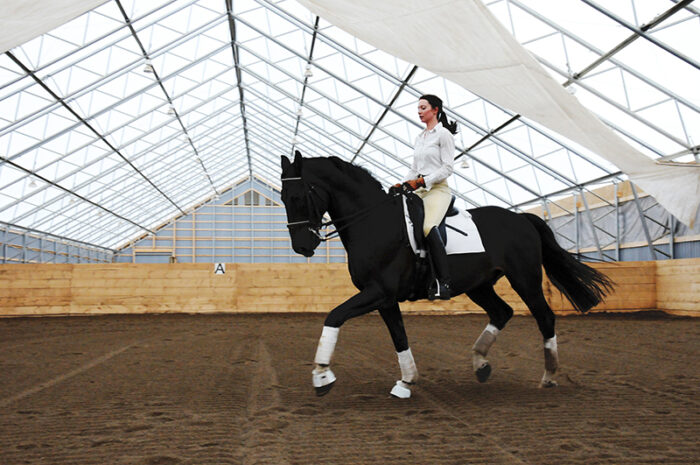
If you’re looking to cut your budget a little, you might be considering forgoing the fencing in your riding arena construction. This can work, but you might have to ask yourself the question, “can your horses get into the arena and destroy anything?”
When building a riding arena on a budget according to TruTex Footing, you don’t have to spend a fortune if you choose a simple style of railing. All it needs to do is create a sufficient barrier between your horses and the riding arena, so they don’t get in and use it as a giant litter box, nor can they get in and interfere with any jumps you have set up.
If you’re doing the fencing yourself, you will want to ensure you do a decent job of it and don’t skimp on the materials to ensure longevity properly. In addition, you might want to look into the costs of using concrete with your fencing; otherwise, you might find that in a few years, your fence will bow out and look terrible.
Fence height is also very crucial. It’s recommended to select a height of 4ft 6in above the riding surface, which translates to around 5ft 6in out of the ground.
What Flooring to Consider?
Horse arena footing is a huge component to consider when working on your horse riding arena budget. Some floor options are much more cost-effective than others, but each has its pros and cons.
Sand
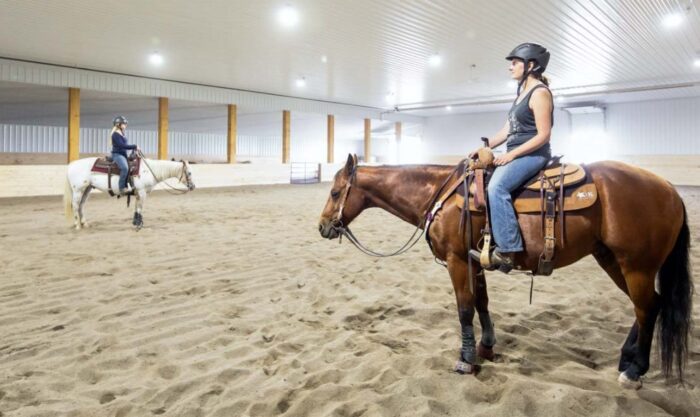
Possibly the most common type of riding arena flooring, sand, can be a cost-effective option. However, one must consider that sand will break down over time and will need to be replaced every few years.
Sand is available in a range of sizes from 0.05 mm diameter (fine) to 2.00 mm diameter (course). One must also be sure to apply the proper depth of sand to create a safe riding arena for the horse.
Try stick to a maximum depth of 6 inches, as more than that becomes stressful on the horses’ tendons. Dust is also a concern when it comes to building an arena, so many people add a water-retentive material such as a wood product or a commercial additive.
Rubber
Rubber for a riding arena can come from recycled shoes or tires ground into small particles. Additionally, it’s essential to ensure the rubber supply doesn’t have any metal remnants or other foreign materials that can injure the horses.
The added benefit of using rubber as a floor is that it’s unlikely that the horses will eat it. Also, adding rubber to something like sand will help cushion the surface, reducing stress on the horse from impact. Rubber is typically added to sand at a ratio of 2 pounds of rubber per square foot.
Adding Drainage to Your Riding Arena
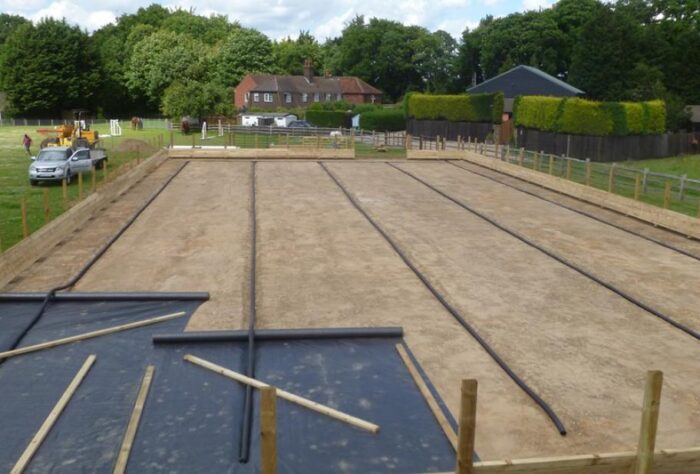
Without proper drainage, your riding arena could soon become a soggy mess after a bit of rain. You will need to know how your surface material handles water. Some bases, like clay, won’t retain a lot of water, whereas a surface base like gravel will hold more water.
It’s essential to consider and plan your drainage, as you don’t want an unusable arena during the rainer months. If your soil is not draining well, you can look into limiting flooding with something like a French drain, which will carry the water away from the arena.
How Big Is Too Big?
Size is an essential factor when it comes to your budget. Increasing the riding area will increase the number of resources you need to build your arena. A more extended riding area will require more fencing and more floor material to cover the whole area.
The most common arena size is 130 ft x 65 ft; however, if your discipline is dressage, you may choose a slightly longer arena closer to 200 ft x 65 ft. If jumping is your discipline, you will want to opt for a wider riding area to fit the jumps. A 20 ft size difference can make all the difference in your jump placement.
Calling in the Professionals
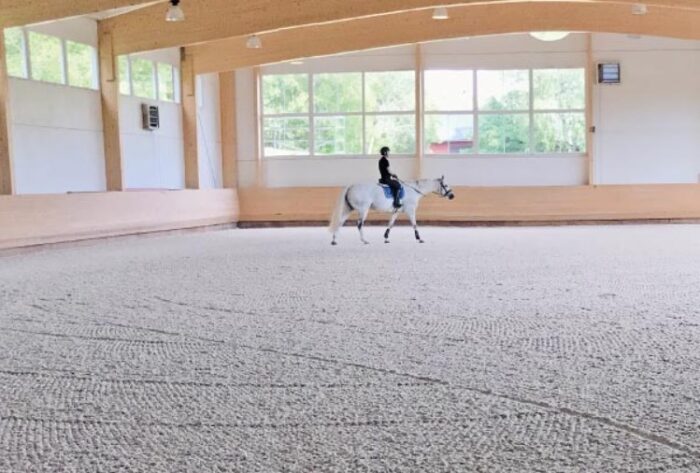
Of course, saving on your budget doesn’t always mean you can’t get professional help. If you consider a riding arena on a budget, many contractors don’t cost an arm and a leg and will allow you to have the riding arena of your dreams. So that’s it on building a riding arena on a budget. If you’ve enjoyed this article, please consider having a further look through our Arena Maintenance section.














